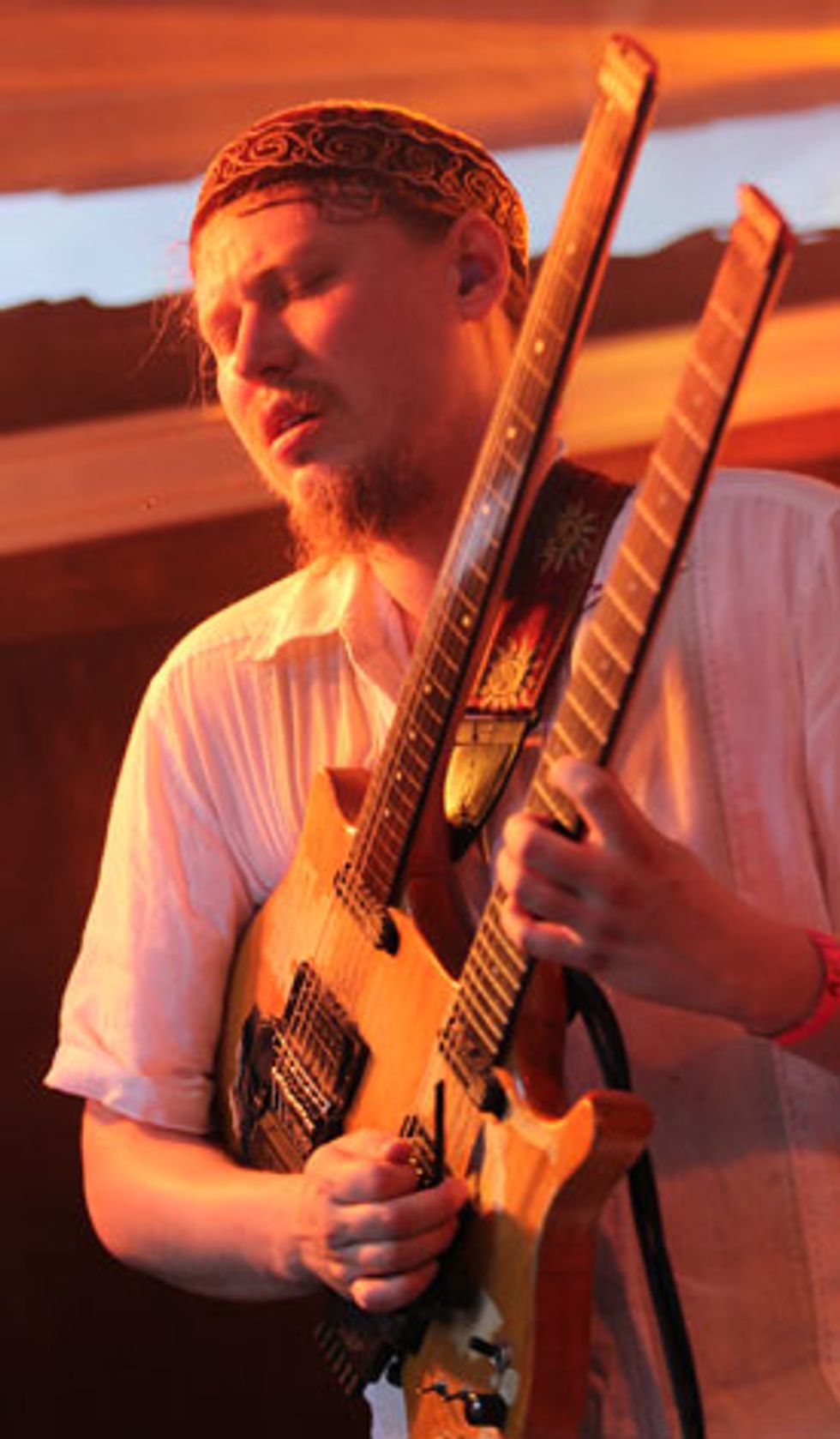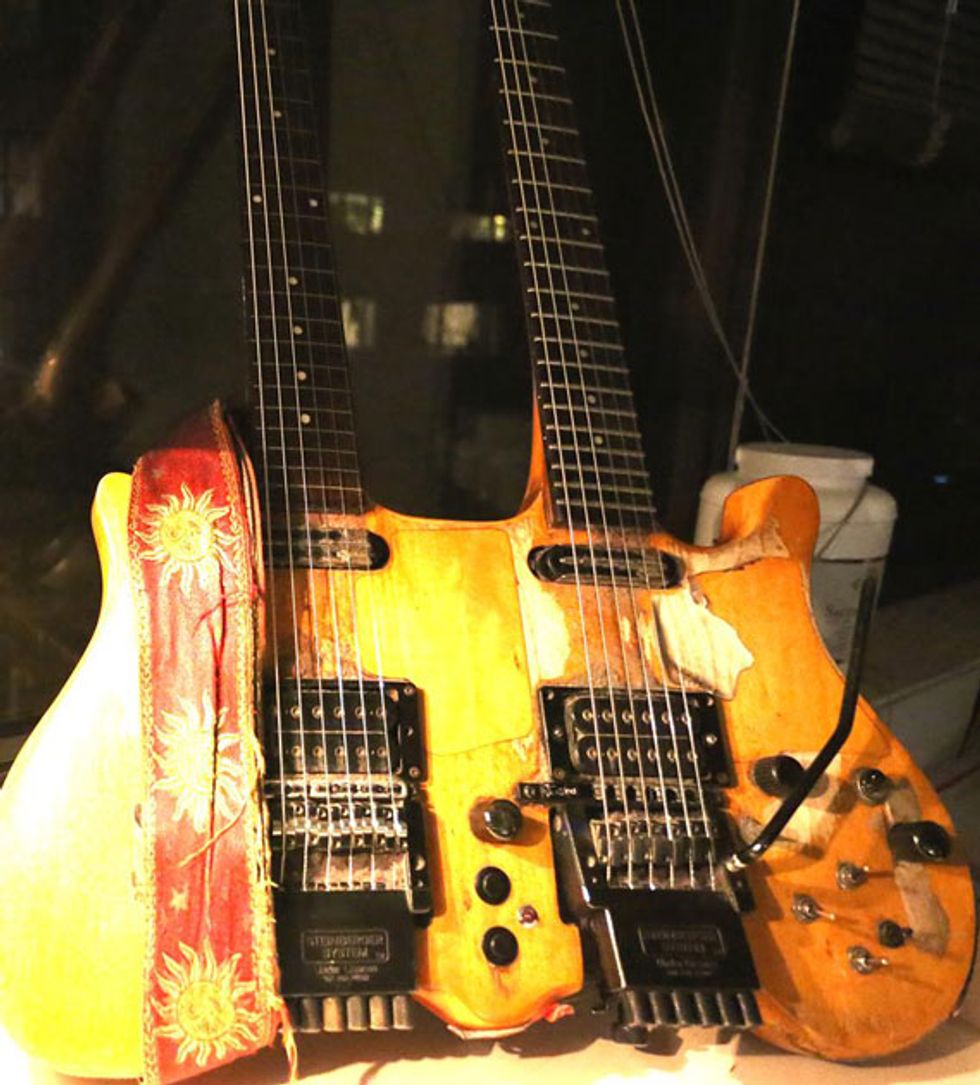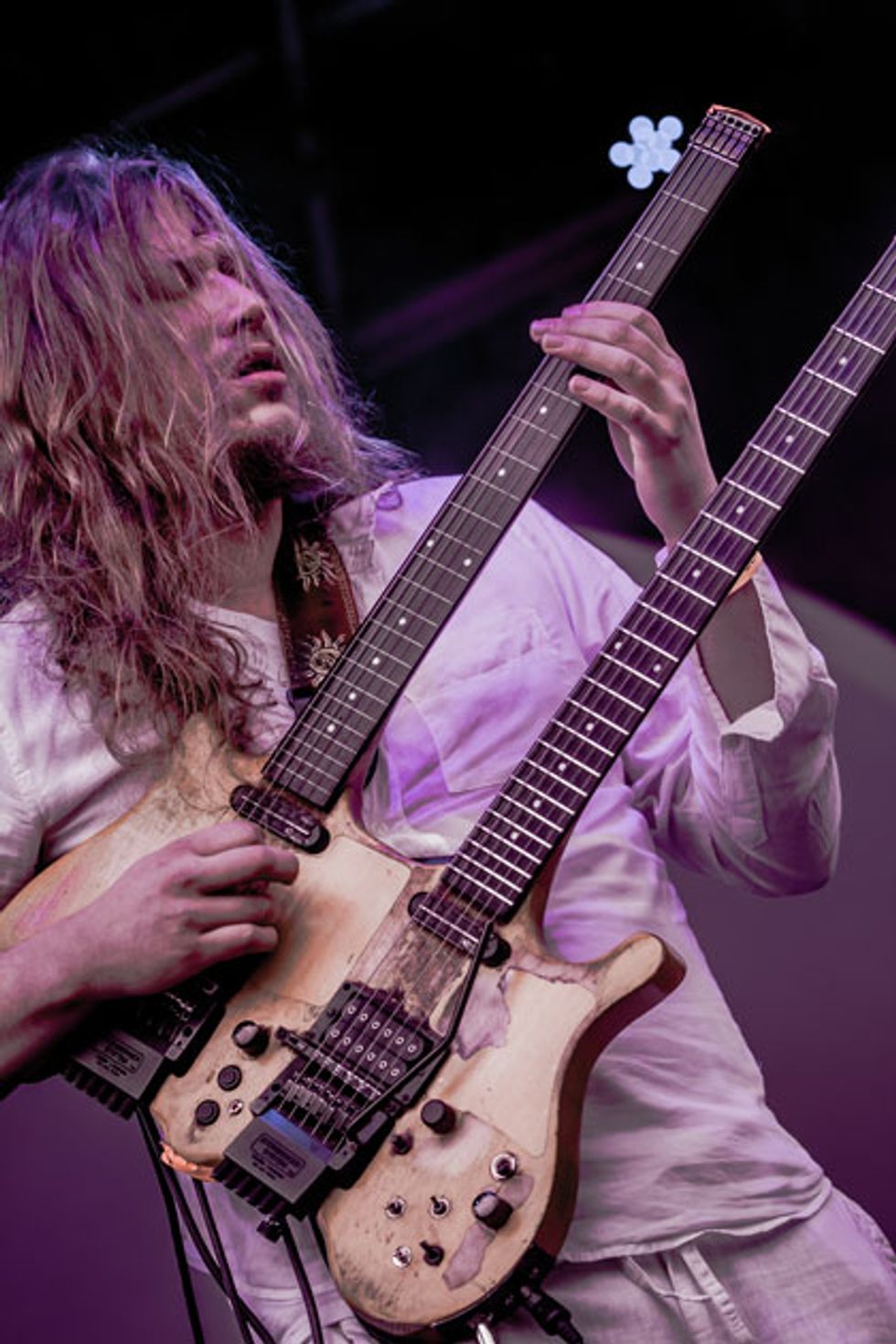Consider the Source’s music is an eclectic mix of ’70s fusion, traditional Middle Eastern and Central Asian styles, prog weirdness, and metal intensity. Guitarist Gabriel Marin boasts insane chops, impeccable time, mastery of diverse traditional scales, rare fretless guitar fluency, and a gift for manipulating effects. He’s also a hardcore gear junkie who tours with three pedalboards, 17 pedals, two guitar synthesizers, two amps, and a well-worn Jim Kozel custom doubleneck.
New York native Marin started on piano and picked up guitar at 16. A year-and-a-half later he was playing Yngwie licks. He earned a bachelor’s degree in classic music from Hunter College, is a disciple of Indian master musician Debashish Bhattacharya, and studied with David Fiuczynski. “I saw a video of [Dave’s] band Kif,” Marin told Premier Guitar. “And I said, ‘That. I need to get with that guy.’” Marin also plays an assortment of traditional acoustic instruments including ba?lama saz, kamancheh, dombra, dutar, tanbour, ?àn b?u, etc.
Marin and his bandmates—thumpmaster/bassist John Ferrara, and drummer/percussionist Jeff Mann—work non-stop. They tour relentlessly, and their upcoming album, World War Trio, will feature over two hours of new music. Its predecessor, 2014’s World War Trio (Part 1) EP, showcased the band’s prog chops and included the 25-minute composition “Put Another Rock in That Bag.” The group recently reworked and recorded their first cover, Radiohead’s “Paranoid Android.” “The same language we use to write one of our own songs, we apply to a beautiful existing song,” Marin says. “It’s a really heavy tune for having been a hit song, so it was really fun to do.”
PG caught up with Marin on tour in New England to discuss fusing traditional and modern music, fretless guitar, Marin’s new custom Vigier doubleneck, Paul Vo’s innovative new MIDI guitar pickup, traveling with so much gear, and the tao of playing really fast.

Photo by Greg Horowitz.
Who were some of your influences?
When I started off I was more into the rock thing, but I was always into different world stuff too. At first my influences were grunge guys and shredders. Jerry Cantrell and Billy Corgan were the grunge guys. I also liked Yngwie [Malmsteen], John Petrucci, and Steve Vai when I was a teenager. It gave me a lot of chops learning to play like that. I was 17, I’d been playing guitar like a year-and-a-half, and I could play Yngwie’s “Far Beyond the Sun.” I was like, “Oh, I can play anything!” [Laughs]. But then I heard [John Coltrane’s] A Love Supreme and John McLaughlin within a two-month period, and it totally changed my music. The chops were so there, but it seemed to mean more. When Coltrane was playing fast lines, it wasn’t, “Look at me playing this fast line.” It was just a spiritual explosion of notes. I thought, “Okay, that’s what I want to do.” I was always uncomfortable with the shredders who put on a show—they would make faces and hold their guitar funny and stuff like that. That didn’t speak to me. And then I heard McLaughlin and Coltrane, and they were playing so well. They meant every note and there was no bullshit, even though they were playing super fast.
You also play super fast.
I talk really fast. I say a lot of words. I play really fast, and I play a lot of notes. That’s just the way it is. Some cats can say something concisely. It just takes me a while to get everything in.
You play many traditional acoustic instruments. How much of that comes out in your electric playing, in terms of techniques, scales, and modes?
That’s a good question. The scales and modes, 100 percent. Anything I play ends up sounding like an Eastern instrument because of the trills and slides that are integrated into my playing from the last 10 years or so. It’s just how I play now. But the right-hand techniques—like from the dombra and dutar—I can’t really put those on guitar. It’s funny, I’ll play dombra or dutar or even saz for a couple of hours, and then pick up the guitar and expect to be ready to play, yet it seems as if I haven’t played at all yet. It’s just totally different.
I think that to do the fusion stuff right, you have to really get inside whatever music you’re trying to fuse. I can perform a concert of Turkish or Persian music authentically, but then [with Consider the Source] I do things that would be considered weird. But I know that I’m doing that. I think it’s important to learn to speak the language the right way first, and then do your own thing.
Once when I was studying Indian music, we were playing this raga. I ended it and, without even thinking, I slid from the minor third to the major third and kind of shook it. It was a little bluesy thing, and it sounded awesome. And my teacher yelled at me for 30 minutes about that because he viewed it as almost disrespectful. That really changed me. I decided, “Okay, when I’m learning this stuff, learn it the right way. When I’m performing it away from this, do whatever I want to it. But keep that separate.”
Photo by Tiffany Kitana of Owleyesonyou.
So you make a real distinction between the traditional way of playing and the way you interpret it with Consider the Source?
Well, mostly because I’m the only one who’s really studied these traditions. I play the melody for [my bandmates] and let them write their own parts. They both are such good musicians that I want them to bring their own things to the table. For example, I don’t want Jeff, our drummer, thinking, “Okay, a Turkish guy on darbuka would play X, so I’m going to play that.” He isn’t a Turkish guy who grew up playing darbuka. He’s a Western guy who’s amazing on drum set. He’ll hear that Turkish rhythm and do his own awesome thing to it, and I like that. We’re not doing traditional music. I study traditional music, but we’re a fusion band.
Can you tell me about playing in odd meters?
When I first started understanding odd meters, it was playing along with a Dream Theater song or something like that—prog rock songs where the odd meters are purposely odd-metered. And then I started playing Balkan music, and that really hit me deep. I took to it—all those ornaments and trills—and I thought, “Okay, here’s a song in nine.” But if you go see it live, you see old women in babushkas dancing. And you think, “How are they dancing in nine? How are they dancing in eleven and seven?” But it’s because the music is broken up into sub-groupings. That made real sense to me, so I started to divide everything into smaller groupings. It doesn’t even seem weird anymore to me. We do a couple of traditional Balkan dance tunes in five, and you see some people getting down and grooving, not even caring. The other night we played a song where the verses are in 15—alternating seven and eight—and this little girl said, “Oh, this is my song!” That felt really cool.
Gabriel Marin's Gear
Guitars
Jim Kozel custom doubleneck (fretless/fretted and equipped with Roland MIDI pickups)
Vigier custom doubleneck (fretless/fretted and equipped with Paul Vo MIDI pickups)
Amps
J&E 30-watt, 2x12 custom combo
Roland keyboard amp (for synth sounds)
Guitar Synth
Roland GR-20 (for fretless neck)
Roland GR-55 (for fretted neck)
Effects
Road Rage Loop Selector
DigiTech Whammy
Boss octave pedal
Customized DigiTech Space Station
Electro-Harmonix Superego Synth Engine
Boss Super Phaser
Ibanez Chorus/Flanger
Ibanez Weeping Demon Wah
Boosta Grande clean boost
Radial Tonebone Classic
Line 6 M9 Stompbox Modeler
Korg Kaoss Pad
EBow
Various volume and expression pedals
Strings and Picks
DR Strings, 010-.046
Clayton Triangle Picks, .80 mm
When you play fretless, are you thinking specific microtones, or are you just going for a feel?
No, it’s very specific. There are different microtonal traditions. For example, the Turkish tradition and the Arabic tradition are very different. If you’re playing a maqam [a set of traditional pitches and their associated melodic figures] in Turkish music, you flat the second to one extent. If you are playing it in Arabic music, you flat it to another extent. Intonation is something I’m very conscious of while playing.
How about with the whammy bar? Are you also specific in how you hit it?
Yes and no. Certain times I just want to make a flutter, or slap at it and see what happens. The whammy bar is a real wild card. It allows you so much room to manipulate the guitar after you play the note. So I’m aware of that aspect of it. With the bar you should be able to bend it to the precise pitches you want, but also be able to just do cool stuff with it.
Watching you play, you dance around the pedalboard a lot. Do you treat pedals as another instrument?
Yeah. When I was a teenager I spent a lot of time messing with pedals. I’m huge sci-fi nerd. One of the things that made me want to play guitar was that my dad took me to Sam Ash and I saw the phaser pedal. I was like, “What’s that? A phaser!?” So the whole nerd music aspect is a big thing to me. I love crazy science-fiction sounds. I went through years of being a huge free jazz guy. I love listening to 20 minutes of guys making squawking sounds on saxophones and stuff like that. I don’t get to do that as much in Consider the Source, but I love making crazy soundscapes with pedals.
There are no keyboards on our albums. People always ask, “Who played keyboards?” No one played keyboards. I use a MIDI guitar. I use a zillion pedals. Rehearsal for me is like, “The third beat of this measure I have to hit this pedal, fourth beat I hit this one, and then the downbeat of the next measure I hit this one.” I don’t use an Axe-Fx or something, where you press one button and everything changes. If I want to turn things on and off, I do them one at a time. There are a couple of points where I have to hit this pedal, spring off, and jump to this pedal. It’s pretty funny looking.
I use EBow a lot, and I have a Korg Kaoss Pad on a stand. I have 17 pedals around me. I have two necks and a billion switches. That’s the aspect of the music that has to be the most conscious. The playing comes from the heart, but you have to have part of your brain on all the time to remember, “Okay, change this setting. Open your eyes now to make this happen.” That requires a lot of conscious thought.
YouTube It
Watch insanity ensue on Gabriel Marin’s doubleneck during a rendition of Radiohead’s “Paranoid Android.” Look for some violin-inspired fingerwork around 4:25.
With all that gear, do you run into problems traveling overseas?
I generally end up bringing the most essential pieces of gear: four or five essential pedals and the guitar. The real problem is the amp. I remember the last time we played in Haifa. Our rider says, “Tube amp at least 40 watts, 2x12 cabinet.” They gave me a Pignose amp. Three hundred people showed up, and I was playing an amplified Pignose miked on a chair. The chair was much bigger than the amp. So I said, “Let’s do a soundcheck. Can you hear it in the house?” And they could. “That was a very interesting tone you had,” they said. I’m sure it was! [Laughs.]
Can you explain your approach to jams and solos?
The song structures remain pretty similar—that doesn’t change. But when the jams come, I consciously try to make them different. For example, if I remember that last night I started a solo up high, I start it down low the next night. It’s hard, because sometimes the night before I did something I really liked. It’s easy to be like, “That was smokin’, let me try that again.” But I try to do the opposite. I’d much rather start from scratch and improvise, even though I might play a terrible solo. That happens sometimes when you’re improvising. But at the same time, it’s necessary, because the next night it may be amazing because of that. I would much rather fail while trying than play something I know and succeed.
Your music reaches a diverse audience.
We play long songs without vocals in odd time signatures with crazy stuff. Everything we do is the opposite of the advice you’d give an aspiring new band. We’re kind of hardheaded in that respect, but we really believe that what we’re doing has the potential to reach a lot of people. We believe that we can go to other countries, play music from another country that they may not have great relations with, and they’ll love it. I remember the first time we went overseas. We went to Israel and then to Turkey, right after they’d had some sort of diplomatic beef. We were in Israel, and we announced that we were going to play in Turkey. They booed—but then we played a Turkish song and they went crazy for it. [After that] we went to Turkey and we said we were just in Israel. They booed. Then we played a klezmer tune and they went crazy for it. Everyone loved everyone else’s music. That’s how it should be. Our crowd is super mixed: old, young, all different ethnicities, metal heads, jam cats. It’s really nice to see that.

Gabe Geeks Out
Gabriel Marin travels with just one guitar: a custom fretted/fretless doubleneck built by Cleveland-based luthier Jim Kozel. Both necks are headless. Both portions of the instrument feature Steinberger bridges, single-coil neck pickups, and bridge humbuckers. Each neck also has a Roland MIDI pickup. Three cables run from the guitar: a standard audio out, plus a cable connecting each neck to its own synth. The guitar weighs in at just under 10 pounds—and it’s been loved. “All that damage—except for one incident—is from me playing on it,” Marin says. “It’s worn, but I like that.”
But after 10 years, Marin is getting a new guitar. “Vigier made a doubleneck for Bumblefoot. They put it on their website and asked, ‘Who do you think this is for?’ A lot of people thought it was for me, so Vigier contacted me.” At first Marin was hesitant because he loves having a headless guitar. “They brought a fretless to my house and I played that metal fretboard,” Marin recalls. He was blown away.
One important upgrade will be new Paul Vo MIDI pickups. “One of the modes is infinite clean sustain. I’ll be able to play the fretless neck like a violin, something I’ve always wanted to do. It also has a mode where it sucks the energy out so the notes have no sustain. There are many Eastern instruments—especially East Asian instruments—that have that sound. Between these new pickups and my big arsenal of pedals and MIDI stuff, there will be years of discovery.”
Marin started using guitar synths a decade ago and has overcome most of the tracking and latency problems many guitarists encounter. “You can’t play fast with a mix of slurs and hammers. You can’t economy pick fast. But for certain sounds, if you alternate pick fast and play precise, it tracks fine.”
Marin points out that different sounds track differently: “If I’m playing with my vibraphone sound on my fretless neck, my intonation has to be so precise. If I intonate slightly sharp, the thing is going to freak out.” He rarely uses presets, preferring to program sounds himself. “I enjoy nerding-out and programing layers upon layers of crazy sounds.”
Marin’s amp is a custom J&E 30-watt 2x12 combo based on a ’59 Bassman. “I don’t want too much in an amp—just a good representation of the sound my pedals are producing,” he says. He runs his guitar synths straight into a Roland keyboard amp.
Marin uses three pedalboards. All his looping is live, performed without a click. “It’s a challenge, but I prefer that,” he says. “I don’t like the idea of quantizing live. I like the human element. If you do it right, you succeed. If you do it wrong, you fail.”











![Rig Rundown: Russian Circles’ Mike Sullivan [2025]](https://www.premierguitar.com/media-library/youtube.jpg?id=62303631&width=1245&height=700&quality=70&coordinates=0%2C0%2C0%2C0)














![Rig Rundown: AFI [2025]](https://www.premierguitar.com/media-library/youtube.jpg?id=62064741&width=1245&height=700&quality=70&coordinates=0%2C0%2C0%2C0)




















 Zach loves his Sovtek Mig 60 head, which he plays through a cab he built himself at a pipe-organ shop in Denver. Every glue joint is lined with thin leather for maximum air tightness, and it’s stocked with Celestion G12M Greenback speakers.
Zach loves his Sovtek Mig 60 head, which he plays through a cab he built himself at a pipe-organ shop in Denver. Every glue joint is lined with thin leather for maximum air tightness, and it’s stocked with Celestion G12M Greenback speakers.











